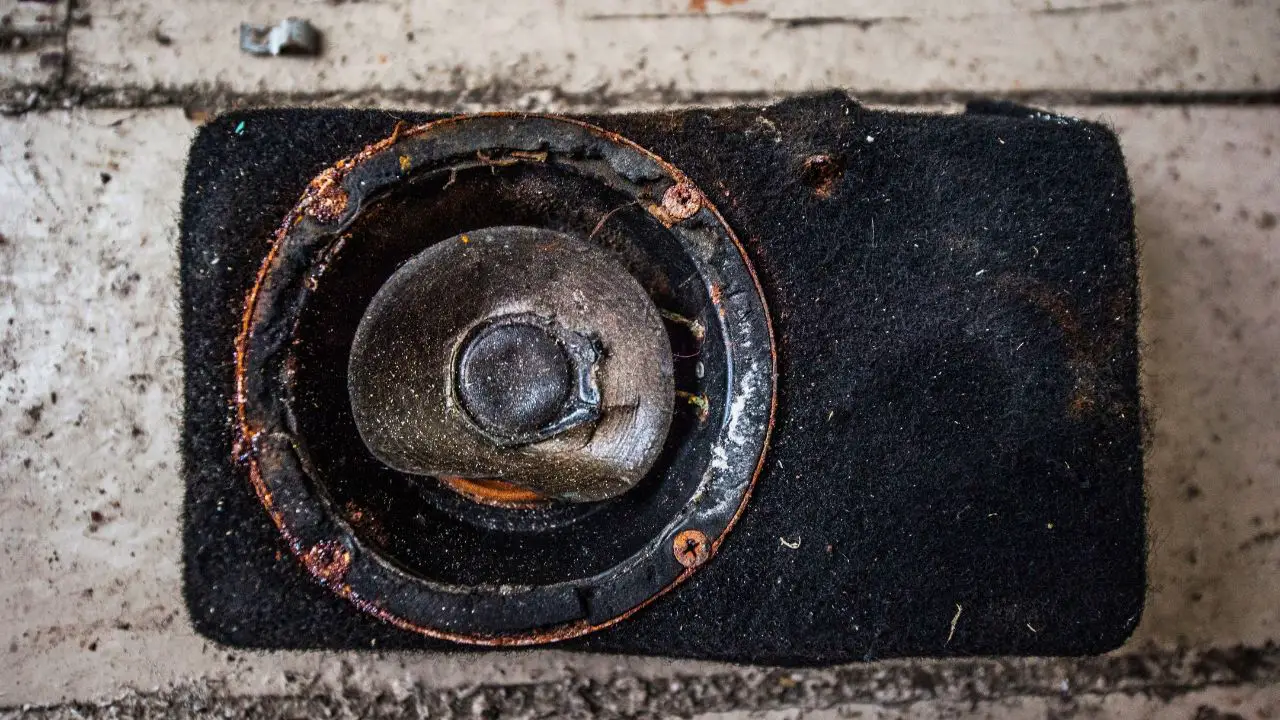Have you ever turned up your favorite song only to be hit with a scratchy, distorted sound? Or perhaps a buzzing noise that just won’t go away? If this has happened to you, then it’s possible that your speaker is blown. But what exactly does a blown speaker sound like, and how can you tell if yours is damaged? In this blog post, we’ll explore the symptoms of a blown speaker, including hissing or buzzing sounds, loss of sound quality and tone range, and complete silence.
We’ll also cover some tips for testing whether your speakers are indeed damaged and what steps you can take to fix them. So buckle up and let’s dive into the world of speaker damage!
In This Article:
What Is A Blown Speaker?
A blown speaker is a damaged device that cannot reproduce high-quality sound due to physical or electrical issues.
Causes Of Speaker Damage
As an audio equipment enthusiast, I have come across different types of speaker damage. In my experience, a clipped signal with the distortion can cause speaker damage and lead to a blown speaker. This happens when the amplifier pushes too much power to the speakers beyond their peak or RMS capability.
Another common cause of speaker damage is physical damage to the cone or voice coil. If these components get damaged from impact, it can cause the sound system to malfunction or stop working altogether. It’s also worth noting that cranking up the volume too high and leaving it like that for too long can cause car speakers to blow out due to overload and harmonic distortion.
How To Tell If A Speaker Is Blown
As an audio engineer, I know firsthand how frustrating it can be to experience a blown speaker. The good news is that there are ways to tell when this has happened. One of the most common signs is distortion at normal volumes. If you notice hissing, buzzing, or other unusual sounds even when the volume isn’t turned up high, it’s likely that your speaker is blown.
Another way to tell if a speaker is blown is to turn up the volume and listen for increased distortion. This happens because the damaged components are struggling to keep up with the increased output demands. You may also notice certain frequencies missing or no sound coming from the speaker at all. These symptoms indicate that something inside the speaker has been damaged and requires repair or replacement.
Overall, there are a few different methods you can use to determine whether your speakers have been compromised. For example, visually inspecting them for signs of damage such as torn cones or burnt components can help identify issues that may not be immediately apparent from listening alone. With some basic knowledge of audio troubleshooting techniques and proper testing equipment, anyone can learn how to diagnose and fix their own audio equipment problems like a pro!
What Does A Blown Speaker Sound Like?
A blown speaker can produce hissing, buzzing, or fuzzy sounds with a loss of sound quality, making it difficult to enjoy your music. But there’s more to learn about identifying and troubleshooting this common audio issue – keep reading to find out how you can diagnose and fix the problem!
Hissing, Buzzing, Or Fuzziness
As someone who has experienced a blown speaker before, I can tell you that it’s not a pleasant experience. One of the most common indications of a blown speaker is when it produces hissing, buzzing, or fuzzy sounds. These noises occur when the voice coil inside the speaker begins to rub against the magnet or the cone itself.
If you hear these types of sounds coming from your speakers, don’t ignore them! They are an indication that something is wrong and needs to be addressed. The distortion caused by partially blown speakers can result in fuzzy sounds when the volume is turned up, making music and other audio sources sound unpleasant to listen to.
Loss Of Sound Quality, Bass, Treble Or Mid-tones
When a speaker is blown, it can result in the loss of sound quality from the speakers. The bass, treble, or mid-tones that were once present may be noticeably absent. This is because a damaged cone and other internal components affect how well they move air to produce certain tones, resulting in an uneven frequency response.
In addition to this, when a speaker is damaged or blown, there will also be distorted sounds permeating throughout your system. The distortion often manifests itself as hissing or fuzziness that wasn’t there before. This fuzzy sound comes from an improperly functioning voice coil that causes electrical disturbances on its way to producing sound vibrations at various frequencies.
When you encounter any sort of distortion or sudden lack of clarity while playing music through your favorite setup, it might be time to get your speakers checked out!
Completely Mute
When a speaker is completely mute, it means that no sound comes out of it. This can happen due to severe damage to the speaker’s components or complete disconnection from the audio source. The most common cause of a completely mute speaker is a burnt-out voice coil, which requires professional repair or replacement.
If you notice that your speakers are not producing any sound at all, it’s crucial to check for loose connections and damaged wires first before assuming the worst-case scenario. A simple reconnection might solve the issue in some cases. However, if you find out that your speakers are indeed blown and have gone completely mute, then it’s time to consider either repairing or replacing them altogether with new ones that offer better audio performance and acoustic quality.
What Does A Blown Speaker Look Like?
A blown speaker may have a torn or damaged cone, melted or burnt components, and poor movement and vibrations. Learn more about the signs of a blown speaker and how to fix it in the next section!
Torn Or Damaged Cone
My experience as an audio engineer has taught me that speakers are not indestructible. They can get damaged due to various factors, including physical injury to the cone or voice coil. When a speaker’s cone becomes torn or damaged, it cannot vibrate correctly and thereby produces distorted and unpleasant sounds.
If you notice a significant reduction in sound quality or hear a rattle, buzz, or scratching sound coming from your speaker, it could be due to a torn cone. The tear weakens the integrity of the cone material and prevents it from efficiently converting electrical signals into acoustics waves. It’s essential to identify this issue and repair your blown speaker as soon as possible before further damage occurs.
Melted Or Burnt Components
If a speaker is severely damaged, it may have melted or burnt components. This indicates that the speaker has been pushed too hard and has overheated, causing some of its parts to melt or burn. Such damage can cause permanent harm to the equipment if not fixed immediately.
When a component in a speaker melts or burns out, it usually leads to total failure of the entire system. In such cases, it’s best to replace the faulty components or purchase an entirely new sound system altogether. Proper maintenance and care of your speakers can prevent this kind of damage from occurring and help you avoid costly repairs in the future.
Poor Movement And Vibrations
When a speaker is blown or damaged, it can often produce poor movement and vibrations. This means that the cone of the speaker may not move as smoothly as it should, which can lead to an unpleasant sound quality. In some cases, a completely stagnant cone might also indicate that there’s a problem with the voice coil.
It’s important to note that this symptom isn’t always present in all blown speakers. However, if you notice any strange movements or vibrations coming from your audio equipment, it’s worth taking a closer look. Checking for any physical damages like tears in the cone or melted components could help determine if your speaker needs repair or replacement.
Blown Speaker Tests
To determine if your speaker is blown, there are a few tests you can conduct, such as inspecting the cone or listening closely for distortion, and even playback and recording. Keep reading to learn more about these tests and how to troubleshoot your audio equipment effectively.
Visually Inspect The Cone
When it comes to detecting a blown speaker, the condition of the cone can help pinpoint any damage. Visually inspecting the cone is a fairly simple process that involves removing the cover and examining it closely for any signs of wear and tear. Look out for cracks, splits, or holes in the surface. Depending on their nature, they could cause sound distortion or make some frequencies hard to hear.
It’s important to handle speakers with care during inspection since cones are often made of delicate materials like paper or plastic. Take note that if you find one small tear in your speaker’s cone but don’t notice any major issues with its sound quality, there may be no need for immediate repair. However, if there is significant damage apparent through visual inspection, then troubleshooting steps must be considered to restore sound clarity and ensure optimal performance from your audio equipment.
Listen Closely For Distortion
When testing for a blown speaker, it’s important to listen closely for distortion in the sound quality. This could include scratchy or buzzing sounds or even complete silence. By turning up the volume gradually, you can determine if the distortion increases and if it persists across different types of audio.
Another effective way to test for a blown speaker is by playing back recorded audio and listening closely for any distortions in sound quality. Pay attention to changes in bass, treble, and mid-tones as well. If you notice any significant differences in sound performance compared to other speakers, this could indicate that your speaker is indeed blown. Remember that maintaining good acoustic conditions and performing routine maintenance on your speakers can help prevent damage and prolong their lifespan.
Playback And Record
When conducting blown speaker tests, two essential methods are playback and recording. First, playback allows you to listen to the sound output of your audio equipment for any distortion or unusual sounds caused by a faulty speaker. By playing different types of music through the system at various volumes, you can better detect any buzzing or hissing noises.
Secondly, recording is another useful method in blown speaker tests. You can record the sound output of your speakers using microphones and then analyze it for any issues like noise reduction or scratching sounds caused by a blown-out loudspeaker. This process can help pinpoint specific problems with your speakers that need fixing.
Both methods of playback and recording are ideal ways to determine if your speakers have been damaged and require repair or replacement. Conducting these simple tests regularly will save you time and money in the long run while also ensuring optimal performance from your audio equipment.
Conclusion
In conclusion, a blown speaker is the last thing anyone wants to experience. The distorted sound quality, buzzing or hissing sounds, and poor vibrations are hard on the ears and can lead to audio fatigue.
However, with proper diagnosis and testing of your speakers, you can rule out any other equipment failure while determining whether it’s time for a replacement or just some simple repairs. Remember that regular maintenance and careful handling of your speakers will keep them in good working condition for longer periods, so give them the TLC they deserve!





